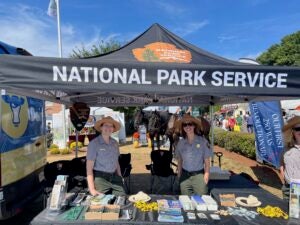In Cambridge Massachusetts, the lives of a USC Trojan, President George Washington, and a beloved American poet, Henry Longfellow, intersect in a house where a war for freedom from the British was fought, where enslaved people longed to escape their masters, and which now reflects the creativity and continuing progress of this nation as a National Historic Site.
USC Alumna in Anthropology, Kaylie Alverez, has been able to dig into the archives of the Longfellow House while serving as a Programming Intern for the Indigenous Artist’s Fellowship with the American Conservation Experience. Alvarez led an effort to look through the archives so that others would know that indigenous collection materials were available at this National Historic Site.
In addition, Alvarez investigated other artist-in-residence programs for best practice models that can inspire the LONG Fellowship for Indigenous Artists that her research is helping create. She explained how important it was “to hear the way the National Park site staff members talked about the residency program. They were moved by the interactions and outcomes. I could see that the impact was felt by everyone, visitors and staff alike.”
Alvarez explained, “I don’t think they’ve introduced indigenous history to the site before, and what I like about the interpretative department is that they’re introducing different histories other than Longfellow’s.” The first-ever LONG Fellowship starts in 2025 when Indigenous artists will be invited to explore the collections of Indigenous histories and create artworks that the Longfellow House can display or incorporate into exhibits that will challenge and inspire visitors.

While in the archives, Alvarez discovered that, “A lot of the material of Longfellow house is tied to The Song of Hiawatha, by Henry Longfellow, which is controversial. In that work, Longfellow attempts to depict Ojibwe legends and people in a way that is appreciative but inaccurate.” At the time of publishing, The Song of Hiawatha captivated White audiences, and many gifts of novelty or touristy Indigenous memorabilia were sent to Longfellow House. Since many of these gift donations lacked information on their true origins, the Longfellow House adopted a system of cross-referencing items with materials already in their archive to determine their provenance. “It’s important that once the fellowship starts, we continue trying to gain understanding and fact-check the materials in the archive and the collections.”
In creating a comprehensive overview of the Indigenous history found at Longfellow House, Alvarez came across letters sent from Indigenous boarding school students from the Hampton Institutes to Alice Longfellow. Alice is Henry Longfellow’s eldest daughter who was instrumental in establishing HBCUs and Native American Residential programs. “The letters from the students to Alice always seemed grateful” Alvarez noted, “but it should be noted that these letters aren’t confidential, and many people were reading them. So, awareness of these outside perspectives and audiences potentially could work their way in.” Examining these letters within the context in which they were written, while maintaining a critical perspective, underscores the broader significance of Alvarez’s research with understanding the complexities of Indigenous history at the Longfellow House.

Alvarez’s discoveries in the archives, particularly the letters from Indigenous students and the complex legacy of The Song of Hiawatha, reflect a broader effort to reexamine the historical narratives tied to the Longfellow House. While conducting her investigation, Alvarez recognized that “The connections we’re finding in this project go beyond just the Song of Hiawatha…and back to the land where the house was built, which originally was the territory of Indigenous people.”
“I didn’t know how this project would turn out once I started, all I knew was the intent explained to me at the outset: to make this National Historic site more inclusive than it may already be and to give the site and its visitors a chance to grow and change despite its history. There are so many avenues to inspire visitors. I’ve seen this in action with our Pride and Juneteenth events. It was such an amazing experience to see people gathering and celebrating at a site like the Longfellow House where I wouldn’t initially think celebrations like this could occur.”

Alvarez hopes to further connections with other National Park and Historic sites in addition to creating new educational materials for Longfellow House that uplift Indigenous history. “I’m also working on a popup that will go in the visitors’ center about Jane Johnston Schoolcraft who was an Ojibwe and Scots-Irish writer. She was one of the first known Native literary writers, but sadly none of her work was published during her time. She started to gain traction in the 1980s. I’m taking up that effort again, nearly 50 years later, by writing about her and her works for the visitors.”
Kaylie Alvarez’s internship with the American Conservation Experience marks a significant step towards inclusivity and understanding within the National Historic Site system. Through her archival research and the establishment of the LONG Fellowship for Indigenous Artists, Alvarez is helping to amplify Indigenous voices and histories that have long been overlooked. The efforts of this USC alumna are creating a lasting impact, inspiring future generations of researchers and artists to explore Indigenous perspectives, while breathing new life into historic monuments like the Longfellow House.